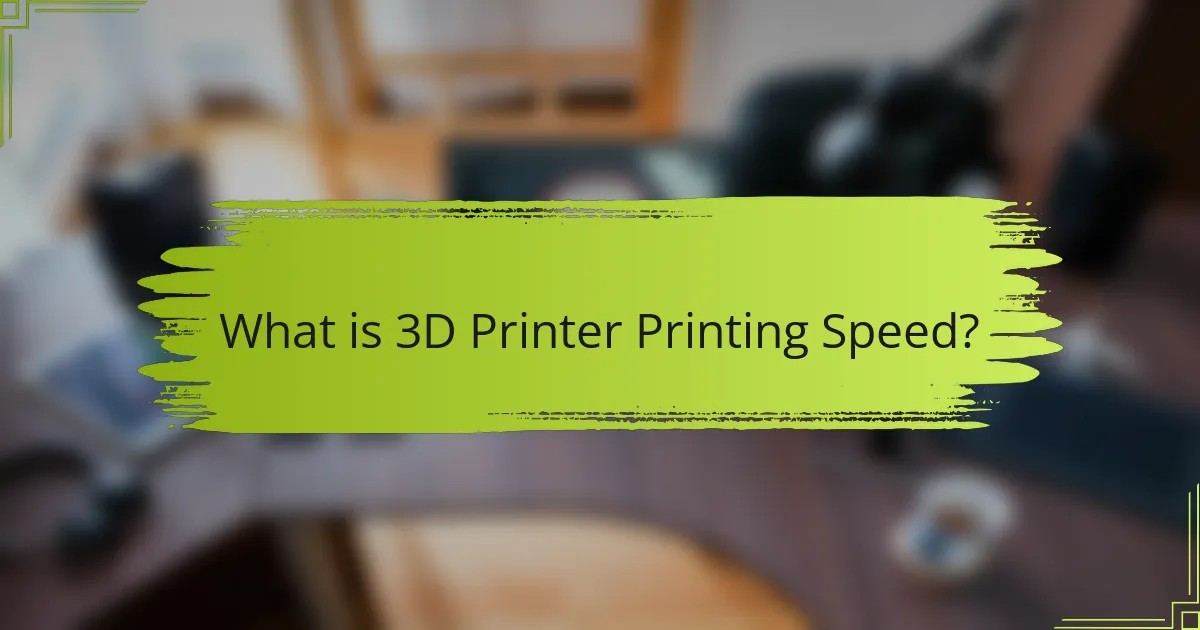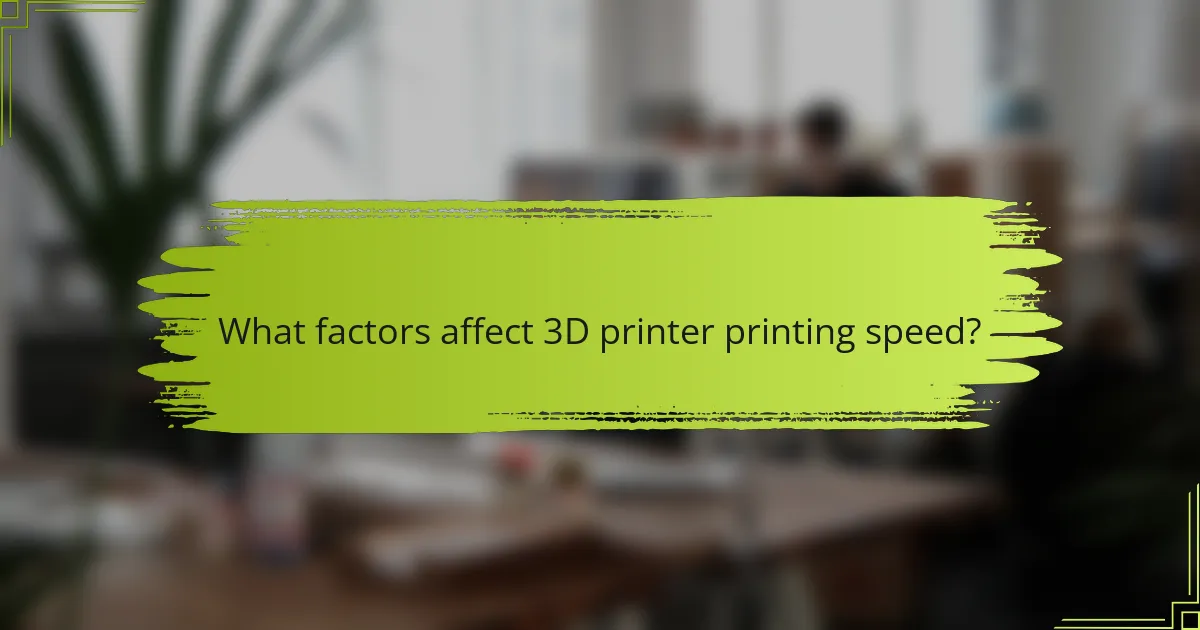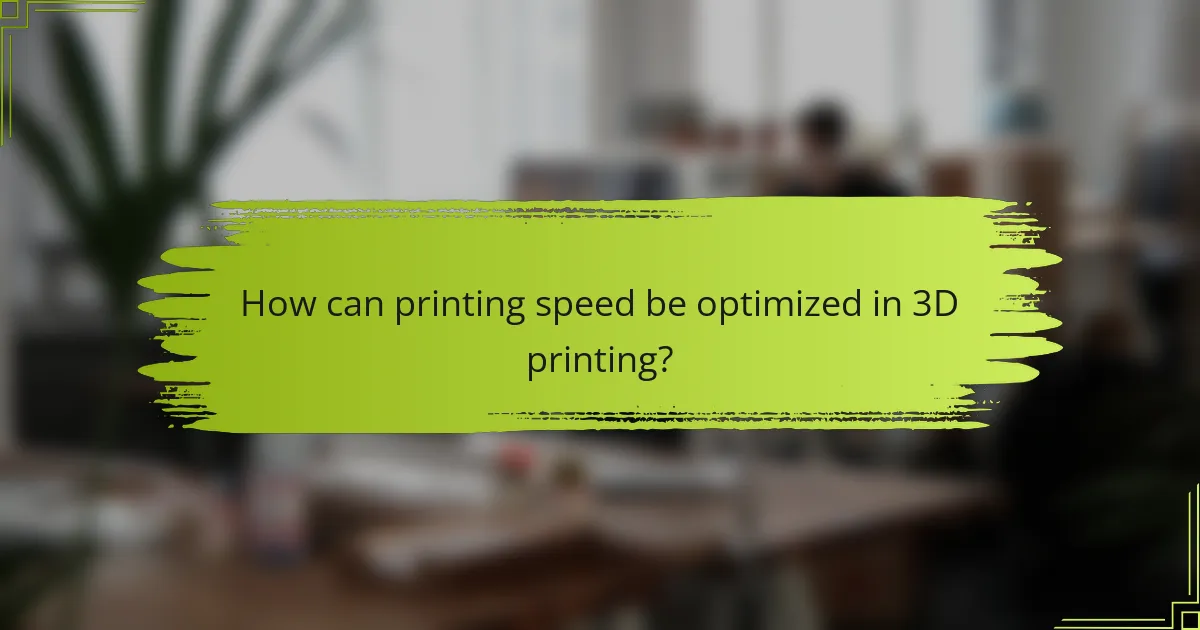
What is 3D Printer Printing Speed?
3D printer printing speed refers to the rate at which a 3D printer can produce an object. This speed is typically measured in millimeters per second (mm/s). Different 3D printers have varying speeds based on their technology and design. For example, FDM printers often range from 30 mm/s to 300 mm/s. SLA printers generally operate at slower speeds due to their layer-by-layer curing process. The speed can significantly impact the quality and detail of the final print. Higher speeds may lead to reduced accuracy and surface finish. Conversely, slower speeds can enhance detail but increase print time.
How is printing speed measured in 3D printing?
Printing speed in 3D printing is measured in millimeters per second (mm/s). This measurement indicates how fast the print head or the build platform moves during the printing process. Higher speeds can lead to faster production times. However, increased speed may also affect print quality. For instance, a speed of 50 mm/s is common for many consumer 3D printers. Some advanced printers can achieve speeds of over 200 mm/s. The optimal speed varies based on the printer model and material used. Therefore, it is essential to balance speed and quality for effective 3D printing.
What units are used to quantify printing speed?
Printing speed is typically quantified in millimeters per second (mm/s). This unit measures the distance a 3D printer’s nozzle travels in one second. For example, a printer with a speed of 50 mm/s moves its nozzle 50 millimeters in one second. Additionally, some printers may also use inches per hour (in/h) for speed measurement. This is less common but still relevant in certain contexts. The measurement of speed directly impacts the time required to complete a print job. Faster speeds can lead to shorter printing times but may affect print quality.
How does layer height influence printing speed measurements?
Layer height directly affects printing speed measurements in 3D printing. A smaller layer height results in more layers being printed for the same object, which increases the total printing time. Conversely, a larger layer height reduces the number of layers, thus decreasing the printing duration.
For example, printing with a layer height of 0.1 mm may take significantly longer than printing with a layer height of 0.3 mm for the same model. Research indicates that layer heights between 0.1 mm and 0.3 mm can lead to variations in printing speed by up to 50%. This demonstrates that adjusting layer height is a critical factor in optimizing print speed while balancing print quality.
Why is printing speed important in 3D printing?
Printing speed is important in 3D printing because it directly affects production efficiency and part quality. Faster printing speeds can reduce manufacturing time, allowing for quicker prototyping and production cycles. However, excessively high speeds may compromise the accuracy and detail of the printed object. Studies show that optimal printing speeds vary based on material and printer type, impacting layer adhesion and surface finish. For instance, PLA prints best at speeds between 50-100 mm/s for quality results. Balancing speed and quality is crucial for achieving desired outcomes in 3D printing projects.
What impact does printing speed have on production time?
Printing speed significantly affects production time in 3D printing. Faster printing speeds reduce the overall time required to complete a print job. For instance, a printer operating at 60 mm/s can complete a task in half the time compared to one at 30 mm/s. This efficiency is crucial for high-volume production environments. However, increased speed may compromise print quality. Layer adhesion and detail resolution can suffer if the speed exceeds the printer’s capabilities. Therefore, while faster printing speeds decrease production time, they must be balanced with quality considerations to achieve optimal results.
How does printing speed affect the final product quality?

What factors affect 3D printer printing speed?
Printing speed significantly influences final product quality in 3D printing. Higher speeds can lead to reduced detail and precision. This is due to the printer having less time to accurately place material. As a result, layer adhesion may suffer, causing weak points in the structure. Conversely, slower printing speeds often yield better surface finishes and dimensional accuracy. Research indicates that optimal speeds vary by material and printer type. For example, PLA typically prints well at 50-60 mm/s, balancing speed and quality effectively. Maintaining a consistent speed helps prevent issues like warping or stringing, which can degrade the final product.
How do printer specifications influence printing speed?
Printer specifications significantly influence printing speed. Key specifications include print resolution, layer height, and nozzle diameter. Higher print resolutions require more detail, slowing down the process. Layer height affects the thickness of each printed layer. Thinner layers lead to longer print times due to increased layers needed. Nozzle diameter impacts the flow rate of filament. A larger nozzle can extrude more material quickly, enhancing speed. Additionally, the printer’s motor and drive system affect movement efficiency. Faster motors can reduce the time taken for each print. Overall, these specifications directly correlate with how quickly a printer can produce a finished object.
What role does the type of 3D printer play in speed variations?
The type of 3D printer significantly impacts speed variations. Different 3D printer technologies, such as FDM, SLA, and SLS, operate at varying speeds. FDM printers typically have slower speeds due to layer-by-layer extrusion processes. SLA printers can achieve faster speeds due to their use of light to cure resin. SLS printers also offer high speeds by selectively fusing powder materials. The design and capabilities of each printer type influence their maximum print speeds. For instance, FDM printers can range from 30 to 300 mm/s, while SLA printers can reach speeds of 100 mm/s or more. The complexity of the print model and the chosen settings also affect speed. Therefore, the type of 3D printer plays a crucial role in determining how quickly a model can be printed.
How does the nozzle size impact printing speed?
Nozzle size directly impacts printing speed in 3D printing. A larger nozzle size allows for a greater volume of filament to be extruded per second. This increased flow rate can significantly reduce the time it takes to complete a print. Conversely, smaller nozzles extrude less material, which can lead to longer print times.
For example, a 0.8 mm nozzle can print approximately 30% faster than a 0.4 mm nozzle under similar conditions. This is due to the ability of the larger nozzle to deposit more filament in each layer. Additionally, the choice of nozzle size can affect layer adhesion and overall print quality.
In summary, selecting the appropriate nozzle size is crucial for balancing speed and print quality in 3D printing.
What material characteristics affect printing speed?
Material characteristics that affect printing speed include viscosity, thermal conductivity, and layer adhesion. Viscosity influences how easily the material flows through the printer’s nozzle. Higher viscosity materials can slow down the printing process due to increased resistance. Thermal conductivity affects how quickly the material can be heated and cooled during printing. Materials with low thermal conductivity may require longer heating times, impacting overall speed. Layer adhesion is crucial as it determines how well layers bond together. Poor adhesion can lead to defects, necessitating slower printing speeds to ensure quality. These characteristics collectively influence the efficiency and effectiveness of the 3D printing process.
How does filament type influence printing speed?
Filament type significantly influences printing speed in 3D printing. Different filament materials have varied melting points and flow characteristics. For example, PLA filament typically has a lower melting temperature than ABS. This allows PLA to print faster as it requires less energy to melt. Conversely, materials like Nylon may require higher temperatures and slower speeds to ensure proper adhesion and layer bonding. Additionally, the viscosity of the filament affects how smoothly it extrudes from the nozzle. High-viscosity filaments may lead to slower printing speeds to prevent clogging. In summary, the choice of filament impacts both the thermal and mechanical properties during the printing process, ultimately affecting the speed of production.
What is the effect of material viscosity on printing speed?

How can printing speed be optimized in 3D printing?
Material viscosity directly affects printing speed in 3D printing. Higher viscosity materials flow more slowly, leading to reduced extrusion rates. This results in longer printing times as the printer must move more slowly to accommodate the material’s flow characteristics. Conversely, lower viscosity materials enable faster extrusion and quicker printing speeds. Research indicates that optimal viscosity levels can enhance layer adhesion and overall print quality. For example, filament with a viscosity of around 1000 Pa·s is often ideal for maintaining a balance between speed and quality.
What techniques can be used to increase printing speed?
Increase printing speed by optimizing printer settings and hardware. Adjusting layer height can significantly reduce print time. Using a larger nozzle diameter allows for faster extrusion of filament. Increasing print speed settings in the slicing software can also enhance speed. Employing multiple extruders enables simultaneous printing of different materials, reducing overall time. Reducing infill density or using faster infill patterns can help as well. Upgrading to a high-speed printer model improves performance. Using a heated print bed can reduce warping, allowing for faster prints without quality loss.
How does adjusting layer height improve printing speed?
Adjusting layer height improves printing speed by allowing the printer to deposit more material in less time. A larger layer height means fewer layers are needed to complete the print. For example, switching from a 0.1 mm layer height to a 0.3 mm layer height can reduce print time significantly. This reduction occurs because the printer spends less time moving between layers. Consequently, the overall print duration decreases. Additionally, thicker layers can lead to faster cooling times, which can further enhance speed. Studies show that optimal layer height can reduce print times by over 30% without sacrificing significant detail.
What are the benefits of using multiple nozzles for speed optimization?
Using multiple nozzles in 3D printing enhances speed optimization significantly. This configuration allows for simultaneous extrusion of different materials or colors. It reduces the overall print time by enabling larger sections to be printed at once. Additionally, multiple nozzles can improve layer adhesion and print quality. This is because each nozzle can focus on different aspects of the print, such as support structures or intricate details. Research indicates that printers with multiple nozzles can achieve up to 50% faster print speeds compared to single-nozzle setups. Therefore, the use of multiple nozzles is a practical solution for increasing efficiency in 3D printing processes.
What common challenges arise when optimizing printing speed?
Common challenges when optimizing printing speed include material limitations, printer capabilities, and design complexities. Material limitations can affect how quickly a printer can extrude filament. Some materials require slower speeds to prevent issues like warping or stringing. Printer capabilities also play a crucial role. Not all 3D printers are designed for high-speed printing, which can lead to quality degradation. Design complexities can introduce additional challenges. Intricate designs may require slower speeds to ensure accuracy and detail. These factors combined can hinder the overall optimization of printing speed.
How can one balance speed and quality in 3D printing?
To balance speed and quality in 3D printing, adjust print settings strategically. Increasing layer height can enhance speed but may reduce detail. Selecting appropriate print speed settings ensures a balance between time and finish quality. Using high-quality materials can improve the final product without sacrificing speed. Optimizing the printer’s temperature settings also aids in achieving faster prints while maintaining quality. Employing a well-calibrated printer minimizes errors, thus saving time on reprints. Research shows that a careful combination of these factors leads to optimal performance in 3D printing.
What best practices should be followed for efficient 3D printing?
To achieve efficient 3D printing, follow several best practices. Firstly, ensure proper calibration of the 3D printer. Calibration affects print accuracy and quality. Secondly, use the right printing material for your project. Different materials have unique properties that influence print performance. Thirdly, optimize print settings such as layer height, print speed, and temperature. These settings impact both speed and quality of the final product. Fourthly, maintain a clean build surface. A clean surface enhances adhesion and reduces print failures. Additionally, monitor environmental conditions like temperature and humidity. These factors can affect material behavior during printing. Lastly, implement regular maintenance on the printer. Routine checks help prevent mechanical issues that can slow down the printing process. Following these practices can significantly improve the efficiency of 3D printing projects.
3D printer printing speed is a critical factor that determines the rate at which a 3D printer produces objects, typically measured in millimeters per second (mm/s). This article explores various aspects affecting printing speed, including the type of printer technology, layer height, material characteristics, and printer specifications. It highlights the importance of balancing speed and quality, as faster speeds can lead to reduced detail and accuracy. Additionally, it discusses techniques for optimizing printing speed and the impact of using multiple nozzles, while addressing common challenges faced during the optimization process. Understanding these factors is essential for improving efficiency and achieving high-quality prints in 3D printing.